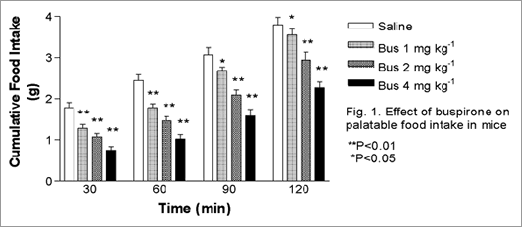101P Brighton
Winter Meeting December 2007 |
EFFECTS OF SUBCUTANEOUS ADMINISTRATION OF BUSPIRONE ON FOOD INTAKE IN CFLP MICE
Ivor Ebenezer, Umar Burki
University of Portsmouth, Portsmouth, United Kingdom
We have previously demonstrated that systemic administration of 5-HT1A receptor agonists, increase food intake in non-deprived rats given access to their normal food but decrease feeding in non-deprived rats given access to palatable food (Ebenezer et al., 2003). The present study was undertaken to investigate the effects of the 5-HT1A receptor agonist buspirone (bus) on food intake in non-deprived CFLP mice given access to (i) their normal food and (ii) palatable food.
Expt.1. Male CFLP mice (body weight: 39 – 42 g, n=32) were divided into 4 groups of 8 and had free access to food and water in their home cages. During the experimental trial, the mice in Group 1 were injected s.c. with physiological saline (Control) and those in Groups 2, 3 and 4 with 1, 2 and 4 mg kg-1 of bus, respectively and presented with their normal food in experimental cages. Food intake was measured, as described previously (Ebenezer et al., 2007). Expt. 2. Male CFLP mice (body weight: 43 - 50 g, n = 8) were housed in a cage with free access to food and water. During the experimental trials, the mice were injected s.c. with physiological saline (Control) or bus (0.5 – 4 mg kg-1) and presented with a palatable wet mash (see Ebenezer et al., 2003) following injection which coincided with the start of the dark cycle. Food intake was measured at intervals over 120 min. Each mouse received all treatments; 3 – 4 days separated successive trials. The data for both experiments were analysed by ANOVA and post-hoc Dunnet’s t-tests. Buspirone produced a dose-related increase in food intake in non-deprived CFLP mice given access to their normal food (Expt. 1). Thus, for example, mean food intake ± s.e. mean at 60 min was as follows: Saline 75 ± 17 mg; bus (1 mg kg-1) 135 ± 19 mg (P<0.05), bus (2 mg kg-1) 171± 30 mg (P<0.01), bus (4 mg kg-1) 163 ± 35 mg (P<0.05). By contrast, buspirone suppressed palatable food intake in non-deprived CFLP mice in a dose-related manner (Expt. 2, Fig. 1). The results of this study show that buspirone increases food intake in non deprived mice given access to their normal pelleted food, but decrease food intake in non-deprived mice given access to palatable food. These finding extend previous observations on the effects of 5-HT1A receptor agonists on food intake in rat to another rodent species.

Ebenezer, I.S. et al. (2007) Eur. J. Pharmacol. 559, 184 – 188
Ebenezer, I.S. et al. (2003) Meth. Find. Expt. Clin. Pharmacol., 25, 727 – 731
|